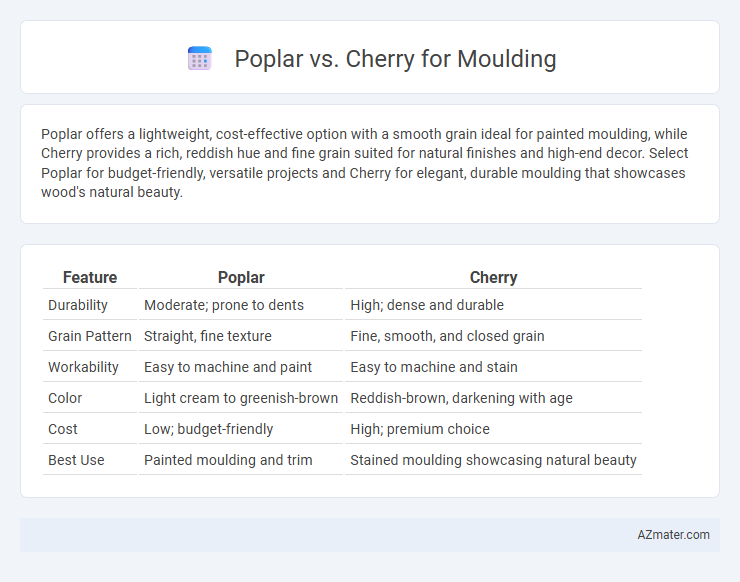Poplar offers a lightweight, cost-effective option with a smooth grain ideal for painted moulding, while Cherry provides a rich, reddish hue and fine grain suited for natural finishes and high-end decor. Select Poplar for budget-friendly, versatile projects and Cherry for elegant, durable moulding that showcases wood's natural beauty.
Table of Comparison
| Feature | Poplar | Cherry |
|---|---|---|
| Durability | Moderate; prone to dents | High; dense and durable |
| Grain Pattern | Straight, fine texture | Fine, smooth, and closed grain |
| Workability | Easy to machine and paint | Easy to machine and stain |
| Color | Light cream to greenish-brown | Reddish-brown, darkening with age |
| Cost | Low; budget-friendly | High; premium choice |
| Best Use | Painted moulding and trim | Stained moulding showcasing natural beauty |
Introduction to Poplar and Cherry Woods
Poplar wood is a lightweight, soft hardwood known for its smooth grain and pale color, making it ideal for interior moulding projects that require easy machining and painting. Cherry wood offers a rich, reddish-brown hue with fine, straight grain that naturally deepens over time, providing a more elegant and durable finish for decorative mouldings. Both woods are popular in woodworking; Poplar excels in affordability and paintability, while Cherry stands out for its aesthetic appeal and sturdiness.
Key Characteristics of Poplar for Moulding
Poplar is valued for moulding due to its lightweight nature and smooth, even grain that allows for clean, precise cuts and detailed profiles. It features a consistent pale creamy to light brown color, which readily accepts paint and stains, making it ideal for custom finishes in interior trim work. Additionally, Poplar's moderate hardness strikes a balance between durability and ease of machining, reducing the risk of splintering or cracking during installation.
Key Characteristics of Cherry for Moulding
Cherry wood for moulding is prized for its rich reddish-brown color and smooth, fine grain that ages gracefully to a deeper patina, enhancing interior aesthetics. Its moderate hardness provides durability while remaining workable for intricate moulding designs, making it ideal for detailed architectural elements. Cherry's natural resistance to warping and shrinking ensures stability in mouldings, contributing to long-lasting, high-quality finishes in both traditional and contemporary spaces.
Durability Comparison: Poplar vs Cherry
Poplar moulding offers moderate durability with a Janka hardness rating of approximately 540, making it suitable for interior applications where resistance to dents and scratches is less critical. Cherry moulding, with a higher Janka hardness of about 950, provides enhanced durability and better resistance to wear, making it ideal for high-traffic areas and more demanding environments. Both woods can be finished smoothly, but cherry's superior hardness guarantees longer-lasting moulding with fewer maintenance needs over time.
Workability: Cutting, Sanding, and Finishing
Poplar offers excellent workability, making it easy to cut, sand, and finish due to its soft texture and uniform grain, which reduces tool wear and allows for smooth, consistent surfaces. Cherry is harder and denser, providing a finer finish but requiring sharper tools and more effort during cutting and sanding, with its natural oils enhancing the final finish's depth and richness. Both woods respond well to staining and finishing, but Poplar's ease of shaping suits intricate moulding, while Cherry's durability and elegant patina make it ideal for high-quality trim.
Cost Differences Between Poplar and Cherry
Poplar moulding is significantly more cost-effective than cherry, with prices often ranging from 30% to 50% lower due to its faster growth rate and abundant availability. Cherry moulding commands a premium price because of its rich color, tight grain, and durability, making it a preferred choice for high-end trim work despite higher material costs. Choosing poplar offers budget-friendly versatility for paint-ready applications, while cherry provides long-term value through its natural aesthetic and resistance to wear.
Appearance and Grain Patterns
Poplar moulding features a light, creamy color with subtle green or brown streaks, showcasing a smooth, straight grain pattern that offers a clean, understated aesthetic ideal for painted finishes. Cherry moulding displays a rich, warm reddish-brown hue that deepens over time, with a fine, straight to wavy grain pattern that adds elegance and character to stained or natural wood applications. The choice between Poplar and Cherry for moulding hinges on the desired visual impact: Poplar provides a neutral canvas for customization, while Cherry delivers a distinctive, luxurious appearance with pronounced grain detail.
Best Uses: Ideal Applications for Each Wood
Poplar moulding excels in interior applications such as painted trim, door casings, and window frames due to its smooth grain and affordability. Cherry moulding, prized for its rich color and natural luster, is best suited for high-end furniture, cabinetry, and decorative trim where a fine, polished look is desired. Choosing poplar ensures cost-effective, versatile use in less visible areas, while cherry enhances aesthetic appeal in premium finish carpentry.
Sustainability and Environmental Factors
Poplar moulding offers a more sustainable choice due to its fast growth rate and renewable qualities compared to cherry, which grows slower and requires longer harvesting cycles. Poplar's lower density also means less energy-intensive processing and reduced transportation emissions, enhancing its environmental footprint. Cherry moulding, while prized for durability and aesthetics, involves higher resource consumption and impact on old-growth forests, making poplar a greener alternative for eco-conscious projects.
Final Recommendation: Choosing the Right Wood for Moulding
Poplar offers a cost-effective, lightweight option for moulding with a smooth grain that accepts paint well, ideal for projects requiring frequent color changes or a modern aesthetic. Cherry provides a rich, warm tone and natural luster that deepens over time, making it a superior choice for high-end moulding and classic interior designs where natural wood beauty is prioritized. Selecting the right wood depends on budget, finish preferences, and the desired longevity of the appearance, with poplar suited for budget-friendly, painted mouldings and cherry optimal for premium, stained installations.

Infographic: Poplar vs Cherry for Moulding
 azmater.com
azmater.com